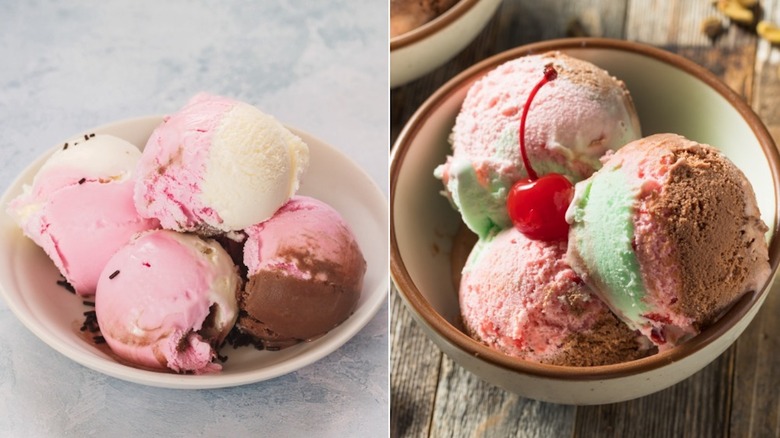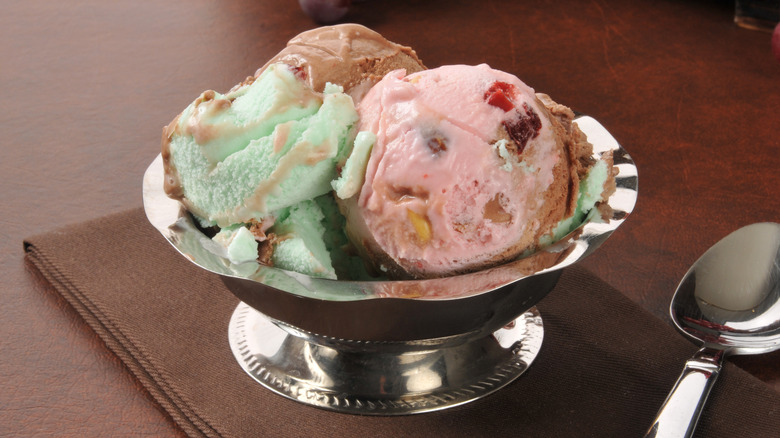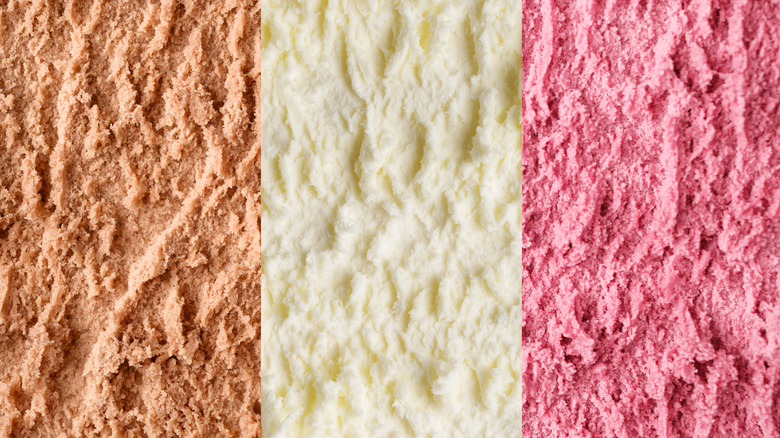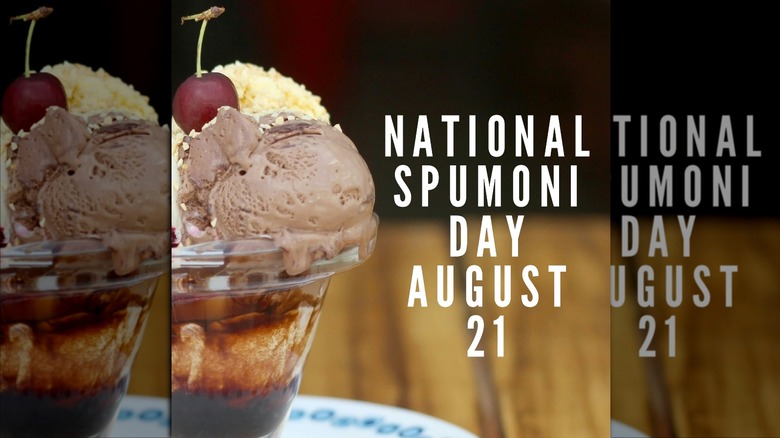The Real Difference Between Neapolitan And Spumoni
Why choose one ice cream flavor when you could enjoy three in one? Such is the logic behind beloved frozen treats like Neapolitan ice cream and spumoni, which give you a variety of flavors in a single bowl or cone — and the relief of not having to make such a limited dessert decision.
It's easy to get Neapolitan ice cream confused with spumoni. After all, both are frozen treats with Italian names, and both come in stripes of three different colors. While Neapolitan ice cream is always brown, pink, and white, spumoni is typically brown, pink, and green. Most people are familiar with Neapolitan ice cream, which ranks number 10 on the International Dairy Foods Association list of best-selling ice cream flavors in the United States. Spumoni, on the other hand, may be lesser known to those living outside of the Northeast. Here's what to know to make sure you never again mistake one flavor for the other.
What is spumoni?
Traditional spumoni isn't really ice cream at all. According to Cook's Info, spumoni in Italy is often a type of frozen mousse containing candy, almonds, and chocolate bits that's covered by a layer of gelato. This is then put into molds and served in a cake-like shape. For the purposes of this article, however, we're talking about spumoni the layered ice cream flavor that is more commonly enjoyed in the U.S. As A Slice of Brooklyn explains, this is technically a semifreddo or sherbet, as it's creamier than a sorbet but has less milk fat than ice cream. The three flavors featured in spumoni vary by region and ice cream shop but typically include a combination of chocolate, pistachio, almond, and cherry. Some iterations are smooth, while others mix in nuts or candied fruit. The flavors can be swirled and scooped or layered, frozen into a loaf shape, and sliced.
One regional spumoni specialty can be found in the New England area, as discussed on Chowhound: spumoni served with claret (a red wine) sauce. One long-defunct Cambridge, Massachusetts, restaurant known as Edelweiss featured spumoni with claret sauce (priced at just 35 cents!) on its 1961 menu (via the New York Public Library). The same item is still available today at Giardino's Family Restaurant in West Yarmouth, Massachusetts.
What is Neapolitan ice cream?
Oh-so-popular Neapolitan ice cream hardly needs an introduction: It likely played a role in every elementary school birthday party you attended, and you may well have experienced the unique type of chagrin that comes with removing a carton from the family freezer and opening it up to find that all the chocolate is gone. Everyone has a favorite flavor in this blend of chocolate, strawberry, and vanilla ice creams.
Most people enjoy Neapolitan ice cream in a classic gallon-sized plastic tub, featuring each flavor in its own one-third-piece block. The familiar flavor combo can be found in ice cream bars and sandwiches, too, and it has also inspired numerous dessert imitations outside the realm of ice cream. Perhaps the best-known of these is the old-school coconut slice candy bar, which you can still find on Amazon. Finally, Neapolitan also lends itself to homemade sweets, like pudding parfaits and cakes.
How spumoni spawned Neapolitan
Interestingly, while Neapolitan ice cream may be more famous than spumoni throughout the U.S., the former is actually derived from the latter. Popsugar explains that immigrants from Naples, Italy, brought spumoni to the States in the late 19th century, and people became quite taken with the dessert's layers of ice cream and flavors. People began to refer to any tri-layered ice cream treats as Neapolitan-style ice cream, eventually elevating the American-favorite trio of vanilla, chocolate, and strawberry to gold-standard status.
Meanwhile, The Chicago Tribune reports that spumoni comes from Bari, a different province in southern Italy, and an Italian immigrant from Naples named Salvatore Lezza brought spumoni to Chicago in the early 1900s. The original recipe he grew up with in Italy likely included almond, semi-sweet chocolate, and stracciatella, but his family business became famous in Chicago for its layers of rum, chocolate, strawberry, and pistachio gelato. Whether the spumoni recipe originally came from Bari or Naples, it made its way to the U.S., grew popular, and inspired the Americanized spinoff of Neapolitan ice cream.
Only one of these ice creams has its own national day
August 21 is National Spumoni Day, although who exactly designated it as such is unclear. Cook's Info reports that the earliest reference the publication could find to the holiday dates to 2001, when it was mentioned in The San Francisco Examiner. Canada also has its own National Spumoni Day, an occasion The Old Spaghetti Factory says is celebrated on November 13 (via Facebook).
There is currently no National Neapolitan Ice Cream Day, which is kind of hard to believe given that a list by National Day seems to indicate that just about every other food on the planet (even lima beans and bologna) has been given its own holiday. One Episcopal priest, however, would like to change all that. In a sermon delivered at Atlanta's Cathedral of St. Philip, the Very Reverend Sam Candler says that Neapolitan Ice Cream Day is the name he gives to Trinity Sunday. Why? He feels that Neapolitan ice cream makes a great metaphor for explaining how God can be both a single entity and yet encompass Jesus and the Holy Spirit, as well.
Both flavors, however, have their own musical tributes
In 1948, a woman named Monica Lewis, singing with bandleader Ray Bloch and his orchestra, released a record titled, "Tony Spumoni (The Ice Cream Man)." We don't know if it was ever a hit, but it did earn digital immortality on the Internet Archive. A virtual spin allows us to hear the tale of a beloved ice cream vendor whose call went like this: "Popsicle, one nickel, two for a dime." Oddly enough, though, the flavor combo called out in the lyrics is "chocolate, vanilla, and nice banan'." Okay, so "strawberry" is harder to rhyme, but was banana ice cream even a thing in the '40s, decades before Chunky Monkey was a gleam in Ben and Jerry's eye?
Neapolitan ice cream's musical ode is a more contemporary one. The song of the same name comes from country music artist Chris Higbee (via YouTube). The song itself has nothing to do with ice cream, but instead deals with all of the things that divide people: region, country of origin, and race. The titular ice cream is used as a metaphor for the unity we should all be striving for, just as chocolate, vanilla, and strawberry — despite their differences — are able to come together in sweet (if chilly) harmony.





